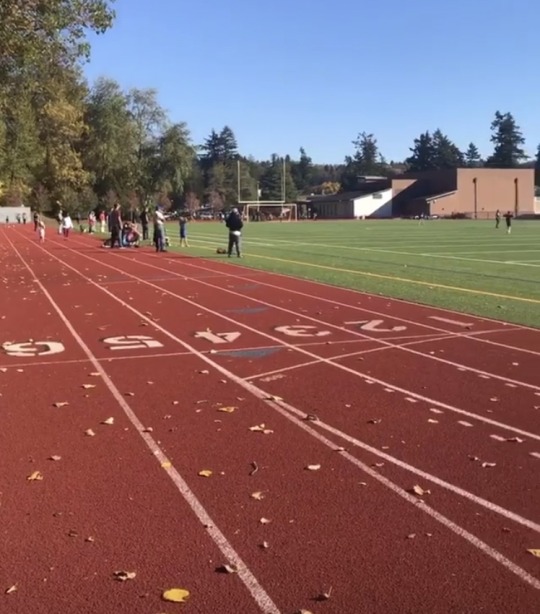
I was so nervous leading up to this.
My first meeting with Coach Frank left me lacking confidence in my running ability, and a horrible cold left me flattened for a few weeks. I felt like I’d lost all my fitness. When I got dressed for the session, I realized it was the first time I’d put on workout clothes since our first meeting two weeks ago. And before that, it had been since mid-September. That’s a big leap from working out six days a week for months at a time!
But my nerves dissipated as I walked onto the track on a beautiful, sunny Saturday and saw my coach finishing up with another client. She was a woman in her late 40s or early 50s, running at a slowish but steady pace. As she ran laps, I asked Coach Frank how long she’d been working with him. He said a few months. First, they worked on form and gait; now, speed.
In our initial meeting, he had mentioned some of the incredibly fast high-school track kids he coaches, so I was happy to see at least one other person who started with him from square one.
I was relieved to find out I wouldn’t be doing much running that day. Instead, we focused on learning 10-12 warmup drills that I should do before every run. I know from my high-school track days, Runner’s World and every serious runner I follow on Instagram that I should warm up—yet I never do! Those days are over. It was so helpful to have Coach Frank walk me through each warmup drill so that I knew exactly what each one should look and feel like. We’ll continue to work on them in upcoming sessions until he’s confident I have them down.
Next, I ran one easy lap around the track—an effort of 4 on a scale of 1-10. I was happy to finish the lap feeling good and not sucking wind like I’d imagined. I could have done a few more! Also, nothing hurt—thank goodness.
Finally, we moved on to two form drills: one for my arms, and one focusing on legs.
Coach Frank told me that I waste energy holding my arms up higher than they need to be and swinging them across my body as I run. I learned to hold them just above my hips, keeping them bent at the elbow at a 90-degree angle as I swing them front to back (or “hip to pit,” as he says) from my shoulders. Keeping my arms at that 90-degree angle is tough, since I’m used to flailing all over the place. It’s a change that won’t happen overnight. I’ll have to practice, practice, practice until it eventually becomes second nature. I can’t wait to see how this alone will change my running!
The final drill involved practicing an exaggerated version of the proper leg motion I should be doing while running; it also involved the arms a bit. It was like a four-step process in slow motion, and there was a lot to think about. I did it several times on each side as Coach Frank gave me correctional cues. With this, as well as the arm-swing drill, the more I overthought it, the worse I did. Every time I was able to relax and let things flow, that’s when I did well. Isn’t that so true of running, too?
I walked away from the track that day with exactly what I wanted: renewed hope and confidence for my running future. And I really like working with Coach Frank so far. He gave clear directions and gentle corrections, plus praise when I did well. He cracked a few jokes. I had fun learning from him! I’ve paid for a package that includes three more sessions, and then I’ll figure out where to go from there.
I have so much work to do before I start training for another race. I’m signed up for the Orcas Island 25K (recap) again at the end of January, so I hope to be able to do that. And the Lake Sammamish Half (2018 recap) is in March, which I feel like is far enough away that I could be ready.
For now, Coach Frank told me to run no more than a few miles a few times a week, and to really focus on warming up properly, cooling down/stretching afterward and practicing the form drills three times per week.
At this point, I’m running zero miles per week because I’m still trying to get over my cold. I’m through the worst of it, but my coughs are still “productive” (gross) and I still have pressure in my sinuses to the point where my teeth hurt. I was feeling a lot better, but then had a pretty active weekend (pumpkin patch, coaching session, family photo shoot on a 40-degree morning) and by Monday felt like I’d taken two steps backward.
I’m really bummed that I’m missing the best month of fall running. The leaves are ablaze and the weather is beautiful. I guess I could be walking, but I’ve been resting as much as possible in the hopes that it will help me get healthy faster.
Plus, I’m actually enjoying being lazy. Maybe I’ll just write off the rest of October and hop back on the workout/running train with—I hope—renewed energy in November.